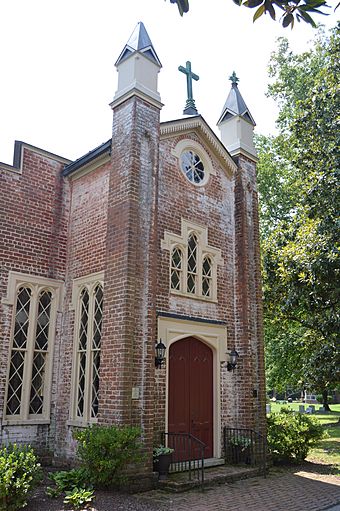Immanuel Episcopal Church (Mechanicsville, Virginia) facts for kids
|
Immanuel Episcopal Church
|
|

Facade
|
|
| Location | SR 606, 1.7 mi. E of jct. with US 360, Mechanicsville, Virginia |
|---|---|
| Built | 1853, 1881, 1916, 1967 |
| Architectural style | Late Gothic Revival |
| NRHP reference No. | 96000577 |
Quick facts for kids Significant dates |
|
| Added to NRHP | May 23, 1996 |
Immanuel Episcopal Church is a historic church and cemetery located near Mechanicsville, Virginia, in Hanover County, Virginia. It belongs to the Episcopal Church, which is a Christian church in the United States.
Contents
A Church with a Long History
Immanuel Episcopal Church was built in 1853. A big part of its creation was thanks to George Washington Bassett. He was a grandnephew of Martha Custis Washington, who was the wife of George Washington. Mr. Bassett matched a donation from St. Paul's Church in Richmond, Virginia.
The land where the church stands was once part of Mr. Bassett's farm, called Clover Lea. An even older church, an Anglican one, stood nearby around 1684. After the American Revolutionary War, the government stopped supporting the Anglican Church. This led to many church buildings being left empty. The Anglican Church changed its name to the Episcopal Church. By the 1840s, the old church building was falling apart. It was used by different groups, including Episcopalians and Baptists.
The new church building was officially opened on April 3, 1854. It was named Immanuel to show it was different from another church in the area.
The Church During the Civil War
During the American Civil War (1861-1865), the people at Immanuel Church supported the Confederate side. The church also served as a hospital during this time. Many battles were fought close by, especially in 1862 and 1864.
Rebuilding After the War
After the war, the area was badly damaged. It took many years for things to get better. The church leaders worked hard to repair the building and make sure the church had enough money to operate.
Several important leaders, called rectors, helped the church grow. A rector is like a main pastor or priest for a church. One rector, Rev. Sewell Hepburn, served from 1881 to 1904. He is related to the famous actress Katharine Hepburn.
Later, Rev. Samuel Chilton became the rector in 1924. He served for 17 years before becoming a bishop. A bishop is a high-ranking leader in the church.
Immanuel Church Today
Over the years, the area around the church changed from rural farmland to part of Richmond's growing suburbs. By 1985, the church had enough members and money to have its own full-time rector.
Rev. Susan Goff served as the church's rector and later became a bishop in Virginia.
The church has also added new buildings over time. A new house for the rector was built in 1957. A building for church activities, called the parish house, was built in 1982. In 1998, a special garden was added for cremated remains.
Church Design and Features
The Immanuel Episcopal Church building is made of brick and has one story. It was built in the Gothic Revival style. This style often includes pointed arches and tall windows, similar to medieval cathedrals.
The church has been expanded several times, in 1881, 1916, and 1967. These additions have given the building a "T" shape when viewed from above.
Around the church, there is a cemetery. This cemetery is also considered historic. It includes the graves of several soldiers who fought for the Confederacy during the Civil War.
The church was recognized as an important historical site in 1996. It was added to the National Register of Historic Places.



